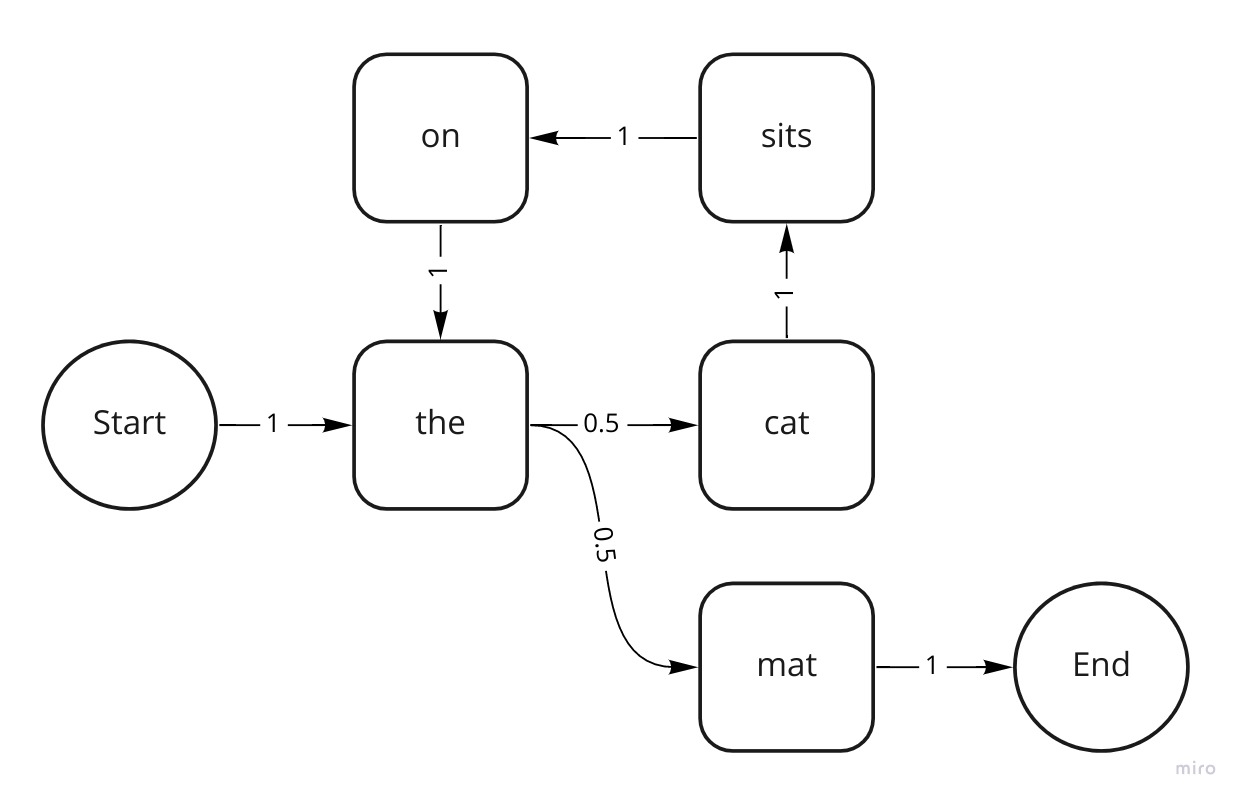Markov movie critic - part 3 - learning
We’ll continue the plan to rate movies with Markov chains.
This time we’ll learn a Markov chain from movie plots.
Model
We’ll use this model
case class Link(to: Token, count: Int)
case class Links(links: List[Link])
case class MarkovChain(map: Map[Token, Links])If we learn a chain from the sentence The cat sits on the mat, it should look like this:
MarkovChain(
Map(
StartToken -> Links(List(Link(WordToken("the"), 1))),
WordToken("the") -> Links(List(Link(WordToken("cat"), 1), Link(WordToken("mat"), 1))),
WordToken("cat") -> Links(List(Link(WordToken("sits"), 1))),
WordToken("sits") -> Links(List(Link(WordToken("on"), 1))),
WordToken("on") -> Links(List(Link(WordToken("the"), 1))),
WordToken("mat") -> Links(List(Link(EndToken, 1)))
)
)The probability to go from the to cat is 0.5, because we’ve seen the cat occur once, divided by the 2 times that we’ve seen the

Learning
Learning is simply a matter of grouping and counting all transitions from each word to the next.
def learn(learnSet: List[Plot]): MarkovChain = {
// Create a list of all transitions from one Token to another, including doubles
val tuples: List[(Token, Token)] = learnSet.flatMap { plot =>
plot.sliding(2).toList.map { case List(from, to) => (from, to) }
}
val transitions: Map[Token, List[Token]] =
tuples.groupBy(_._1).map { case (from, tuples) => (from, tuples.map(_._2)) }
// Count how often transitions occur from Token X to Token Y for all X and Y
val countedTransitions: Map[Token, Links] = transitions.map { case (from, toTokens: List[Token]) =>
val tos = toTokens.groupBy(identity).map { case (toToken, allSimilar) => Link(toToken, allSimilar.size) }
(from, Links(tos.toList))
}
MarkovChain(countedTransitions)
}Output probability
With this Markov chain we can calculate the probability to output a certain plot.
P("The mat") = P(StartToken -> Word("the")) * P(Word("the") -> Word("mat")) * P(Word("mat") -> EndToken)
= 1 * 0.5 * 1
= 0.5
P("The cat sits on the mat") = 0.5 * 0.5 = 0.25
P("The cat sits on the cat sits on the mat") = 0.5 * 0.5 * 0.5 = 0.125
P(all) = 0.5 + 0.25 + 0.125 ...... = 1This is a rather simple Markov chain, which can only repeat "cat sits on the" in the middle a number of times.
If we add up all these (infinite) possibilities, we see that the total probability adds up to 1
This method calculates the probability to output a list of tokens.
def probabilityToOutput(tokens: List[Token]): Double = tokens match {
case List() => 0.0
case List(EndToken) => 1.0
case head :: tail =>
transitions
.get(head)
.orElse(transitions.get(InfrequentWord)) //if this token has not been learned on
.map(_.probabilityToOutput(tail.head) * probabilityToOutput(tail))
.getOrElse(0.0) //if it also has not learned InfrequentWord
}In the next part we’ll use this probability to make a classifier
